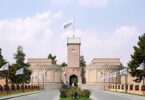Iqbal Khan
The US and Taliban delegates wrapped up their sixth round of peace talks on May 09 with “some progress” made on a draft agreement for when foreign troops might withdraw from Afghanistan, a Taliban official said. “The 6th round of talks … ended, with some progress made on the draft agreement prepared in the last round of talks,” tweeted Muhammad Sohail Shaheen, spokesman for the Taliban’s political office in Doha.
The New York Times reported on May 07: “The American military command in Afghanistan has halted regular assessment of how many people and districts the government and the insurgents’ control—eliminating what has long been an important public measure of progress in the war”. For quite some time, this data had been embarrassing for the US Force commander in Afghanistan because larger and larger area has been slipping into Taliban control. Now at best, the US is hoping for an armistice that could be projected as victory.
The US special envoy Ambassador Zalmay Khalilzad has said that America stands ready for “all sides” to lay down arms. “All sides laying down arms is the outcome of any peace process,” Khalilzad tweeted. “All sides agreeing to reduce violence is a necessary step toward achieving that outcome and the morally responsible choice to make. We stand ready.” Khalilzad’s comments come a day after Afghan President Ashraf Ghani said he was prepared to call an “immediate” and “permanent” ceasefire — but the Taliban appeared to rebuff the offer. Taliban spokesman Zabihullah Mujahid tweeted that America should “forget about the idea of us putting down our arms” and “stop repeating failed strategies & expecting different outcomes.”
He issued a series of sharp tweets in response to Khalilzad’s tweet that called on the Taliban to “put down arms, stop the violence, & embrace peace”. “Instead of such fantasies, he should drive the idea home (to the US) about ending the use of force and incurring further human and financial losses for the decaying Kabul administration.”
Prior to starting the latest round in Doha, Khalilzad had visited Islamabad. He requested and received support for the need to accelerate intra-Afghan dialogue and negotiations as well as a reduction in violence, alongside formulation of concrete steps necessary for a comprehensive settlement, said a statement issued by the US Embassy in Islamabad. Khalilzad reiterated that an end to the war for Afghans will bring long overdue peace and stability that precludes it from being used by terrorists to attack the United States or any other country.
Earlier Khalilzad also went to Moscow, where Russia and China voiced support for the US plan for a peace deal and stressed the need for intra-Afghan dialogue that would see all sides in Afghanistan at a negotiating table. Earlier the US found backing from rivals Russia and China on the key formula of a peace deal it is negotiating in Afghanistan – withdrawing troops in return for Taliban pledges not to welcome foreign extremists. Khalilzad called the consensus a “milestone” in efforts to end the war after he met Russian and Chinese representatives in Moscow.
A joint statement by the three countries called for an “inclusive Afghan-led” peace process and outlined points expected to feature in an eventual agreement. “The three sides call for an orderly and responsible withdrawal of foreign troops from Afghanistan as part of the overall peace process,” said the statement issued by the US State Department. Khalilzad said that the statement, along with his earlier talks in London with European envoys, “means we have an emerging international consensus on US approach to end the war.”
However, Pakistan’s valuation about the future of Afghanistan sees the neighbouring country engulfed in a ‘civil war’ again with the US and the Taliban failing to reach a peace deal. Afghan Grand Council, commonly known as Loya Jirga, was convened by President Ashraf Ghani ended on May 03, Council made a unanimous call for peace with the Taliban. Ghani offered the Taliban ceasefire and promised to release 175 Taliban prisoners ahead of the holy month of Ramazan. “We do not want to be pessimistic, but the situation on the ground suggests that there is a remote chance of the ongoing talks between the Taliban and the US leading to any peace deal,” said a senior Pakistani official. The crux of that assessment is that Afghanistan in all likelihood is heading towards a ‘civil war’. There are a number of factors which might push Afghanistan towards further unrest.
Pakistan now has very limited influence over the Taliban. It is believed that in view of the grim perspective of any political solution, Pakistan is now trying to maintain a low profile in those talks. Unlike, the earlier talks held in the UAE, Pakistan is not directly taking part in the ongoing Doha parleys, although it has facilitated the process.
In the event of further instability, there is fear of new influx of refugees. Pakistan is working out ‘contingency plans’ to cope up with such eventuality. One area that Pakistan has been working on for a couple of years is to fence the long and porous border with Afghanistan. The fencing is primarily meant to ensure better border security and control the irregular movement of people, something that militants always take advantage of. Earlier welcoming an Afghan Track-II delegation, Foreign Minister Shah Mahmood Qureshi conveyed Pakistan’s strong desire for a peaceful and stable Afghanistan.
He stated that renewed push for political settlement of the conflict has created new hopes and opportunities for peace in Afghanistan. However, all stake holders need to take bold steps to undo the uncertainty shrouding multiple initiatives for peace in Afghanistan.






